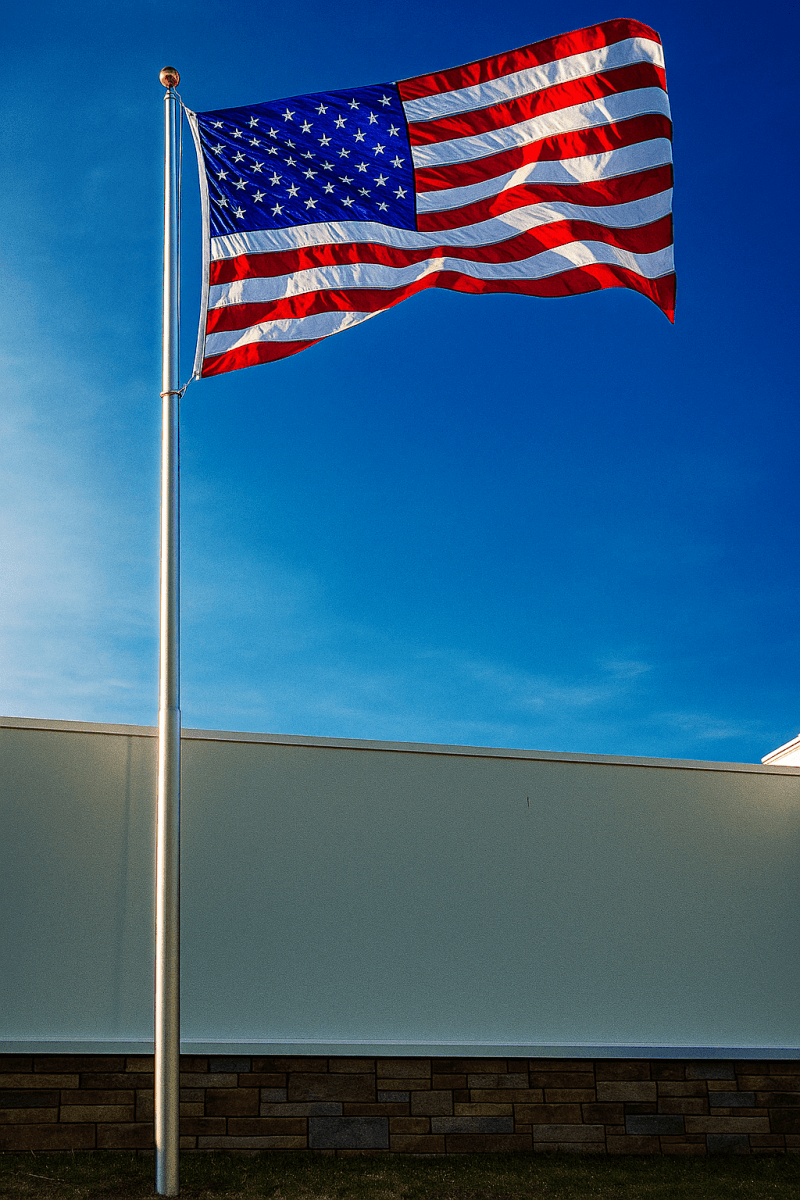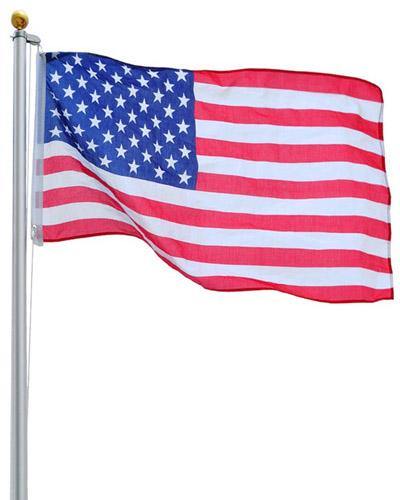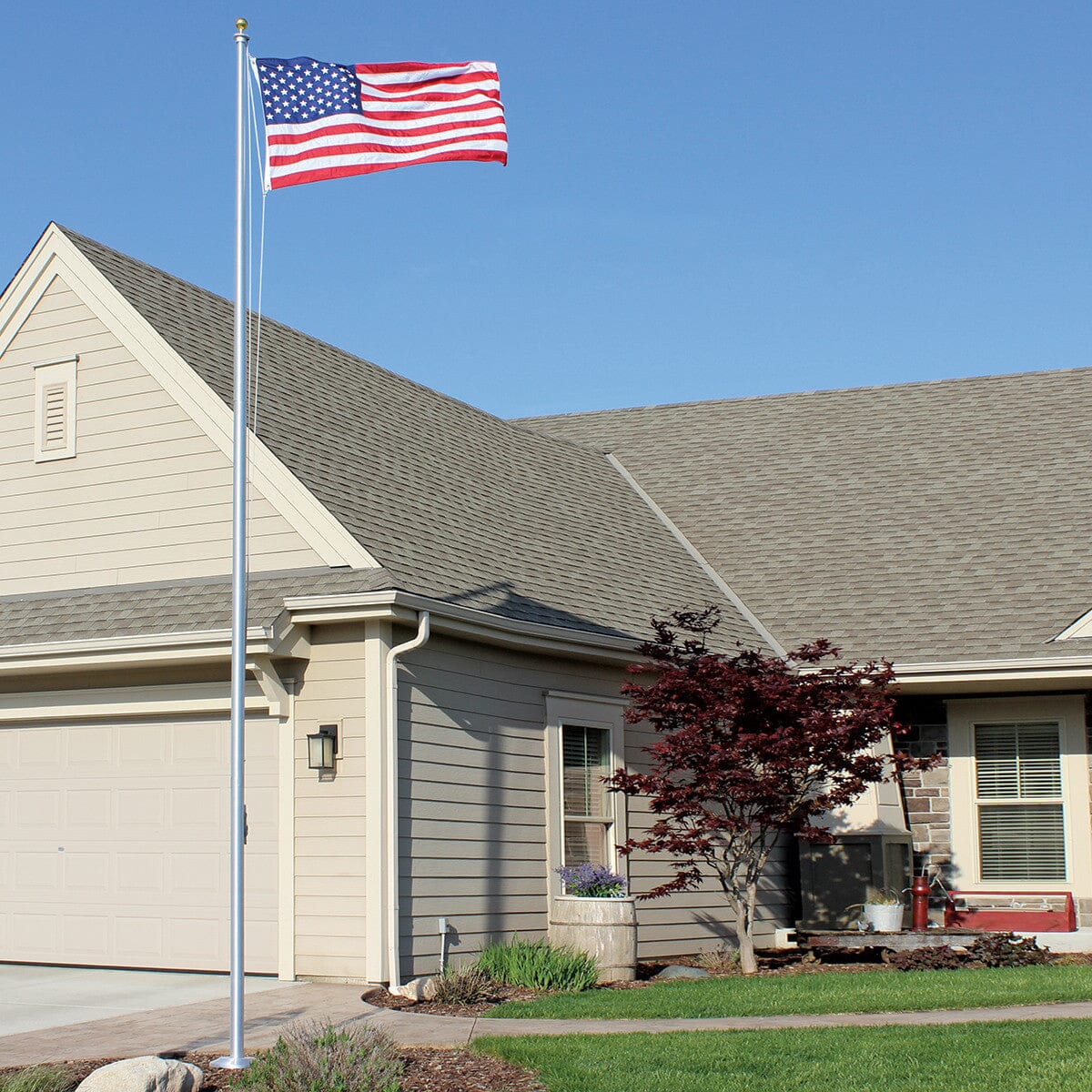Few things frustrate flag owners more than seeing their American flag tangled around the pole instead of waving proudly in the wind. This common problem goes beyond mere appearance—repeated twisting wears down your flag, frays the halyard, and can damage pulleys or hardware over time. The good news? With the right setup and simple maintenance, you can stop most tangling and keep your flag flying free. Below, we’ll reveal the best ways to prevent your halyard from tangling on a flagpole.
What Is a Halyard and Why Does It Matter?
The halyard is the rope or cable that raises and lowers your flag. It runs through pulleys at the top of the pole and directly affects how your flag flies. Most residential flagpoles use external halyard systems, where the rope is visible and easy to access for flag changes or repairs. Internal systems hide the halyard inside the pole, offering better protection from weather and tampering but requiring more maintenance.
No matter the system, a well-maintained halyard helps your flag move naturally with the wind. A worn or poorly functioning halyard, on the other hand, invites tangling and damage.
Top Reasons Your Halyard Gets Tangled
A tangled halyard is often the result of a few common issues. Knowing what causes the problem is the first step to preventing it.
Wind Direction and Turbulence
Changing wind directions cause your flag to shift, twisting the halyard with each movement. Nearby obstacles such as trees, buildings, or vehicles make it worse by creating swirling, unpredictable air patterns. Where you place your flagpole can significantly impact how often tangling occurs.
Poor-Quality or Worn-Out Halyards
Old, frayed halyards twist more easily and can’t handle constant motion. Sun, rain, and temperature swings break down rope fibers over time. Thin or low-quality ropes are especially prone to kinking. For best results, use durable materials such as polyester or nylon.
Incorrect Flag Size or Improper Mounting
Flags that are too large for the pole catch more wind and pull harder on the halyard, increasing tangling. Loose attachments let flags slide, while tight ones restrict movement. Flag size and mounting height should match your pole’s specs to allow smooth motion.
Improper Use or Maintenance
Neglecting regular inspections lets small issues grow. Twisting that goes unchecked only worsens with time. Skipping basic upkeep, such as lubricating pulleys or replacing worn rope, invites tangling. Consistent maintenance keeps your flag system running smoothly.

Preventative Measures: How To Keep Your Halyard Tangle-Free
Preventing tangles starts with smart upgrades and regular upkeep. Here are the most effective ways to keep your halyard — and flag — flying freely.
Use Rotating Truck Assemblies
Rotating truck assemblies let your flag move with the wind instead of fighting it. Mounted at the top of the pole, these devices use ball bearings to allow smooth, 360-degree rotation. This prevents the halyard from twisting when wind direction shifts.
Add Anti-Wrap Devices
Anti-wrap devices such as flagpole spinners, swivels, and specialized clips work with the wind to keep your flag flying freely. Spinners allow the flag to rotate around the pole as the wind shifts, while swivels let the flag turn independently from the halyard, reducing stress on the rope. These small accessories take only minutes to install but can significantly reduce twisting and wrapping. Many are compatible with both residential and commercial flagpoles, making them easy upgrades for nearly any setup.
Upgrade to a Tangle-Free Flagpole Design
Telescoping flagpoles use rotating clips and eliminate the need for a halyard altogether. The flag attaches directly to the pole, preventing the wrapping and twisting that traditional ropes cause. Many of the modern flagpoles for sale feature this tangle-free design, making them a top choice for homeowners who want a clean, low-maintenance setup.
Choose the Right Flag Size
Using a flag that’s too large for your pole increases wind drag and halyard strain. Stick to manufacturer guidelines that match flag size to pole height and local wind conditions. A properly sized flag flies better and lasts longer.
Regular Maintenance and Inspection Tips
Check your halyard monthly for fraying, stiffness, or signs of wear. Raise and lower the flag to test the pulley function—they should operate smoothly without grinding or sticking. Lubricate all moving parts once a year using marine-grade grease to protect against rust and corrosion.
Replace damaged ropes, clips, or pulleys as soon as you notice issues to prevent bigger problems. A few minutes of maintenance can extend the life of your entire flag system and keep your display looking sharp year-round.
Pro Tips for Windy Areas
Homeowners living in consistently windy regions face unique challenges that require specialized solutions. Consider upgrading to heavier-duty halyard materials that resist stretching and twisting under constant stress. Reinforced clips and hardware designed for high-wind applications provide additional security and longevity.
Internal halyard systems offer superior protection in extremely windy conditions. While they’re more complex to install and maintain, these systems eliminate external rope exposure to wind forces, dramatically reducing tangling potential. The best way to prevent your halyard from tangling on a flagpole in high-wind areas often involves using this type of protected system.
Some manufacturers offer wind-specific flagpole designs that incorporate aerodynamic features to minimize turbulence around the pole itself. These specialized poles create smoother airflow patterns that reduce the chaotic wind conditions responsible for flag wrapping.

Should You Switch to an Internal Halyard System?
Internal halyard systems provide excellent tangle prevention but require careful consideration of trade-offs. These systems shield your halyard from weather exposure and potential vandalism while significantly reducing tangling incidents. The enclosed design prevents external forces from directly affecting the halyard’s movement.
However, internal systems complicate flag changes and maintenance procedures. Accessing the halyard for repairs or adjustments typically requires specialized tools and techniques. Commercial applications often justify these complications due to the enhanced security and reduced maintenance requirements.
For residential use, internal systems work best when professional installation ensures proper setup and homeowners understand the maintenance requirements. The reduced tangling alone often justifies the additional complexity for homeowners frustrated with constant flag unwrapping duties.
Keep Your Flag Flying With Pride
Preventing halyard tangling takes the right mix of quality equipment, proper installation, and consistent maintenance. The best way to stop your halyard from twisting starts with understanding the causes and taking action before issues develop.
Whether you go with a rotating truck assembly, anti-wrap devices, or a modern tangle-free design, investing in quality solutions reduces frustration and keeps your flag flying proudly. Proper flag sizing and regular upkeep round out the formula for a smooth, reliable flag display.
If you’re still dealing with tangling despite these steps, it may be time to upgrade your setup. Visit Liberty’s installation resource page for expert tips, product guidance, and step-by-step help in choosing the right system for your needs.







